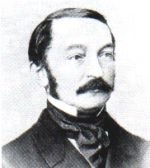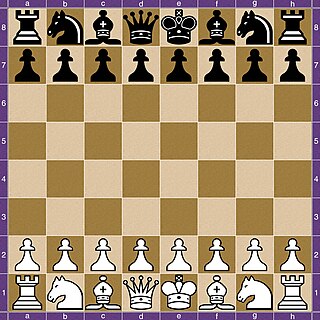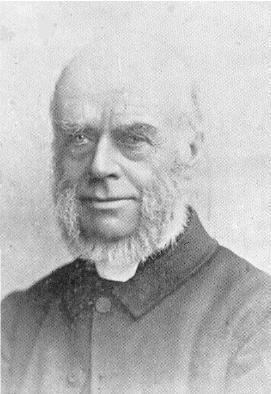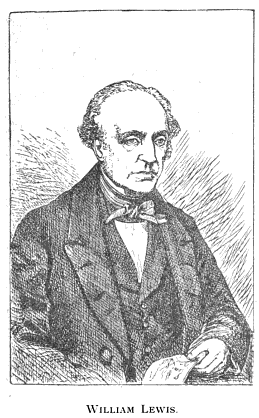
Howard Staunton was an English chess master who is generally regarded as the world's strongest player from 1843 to 1851, largely as a result of his 1843 victory over Pierre Charles Fournier de Saint-Amant. He promoted a chess set of clearly distinguishable pieces of standardised shape – the Staunton pattern promulgated by Nathaniel Cooke – that is still the style required for competitions. He was the principal organiser of the first international chess tournament in 1851, which made England the world's leading chess centre and caused Adolf Anderssen to be recognised as the world's strongest player.
The Ruy Lopez, also called the Spanish Opening or Spanish Game, is a chess opening characterised by the moves:
The Grünfeld Defence is a chess opening characterised by the moves:
The King's Gambit is a chess opening that begins with the moves:
The Dutch Defence is a chess opening characterised by the moves:

John Cochrane was a Scottish chess master and lawyer. After serving in the Royal Navy Cochrane chose to become a barrister. While studying law, he became a very strong chess player and published a book on the game, which included the Cochrane variation of the Salvio Gambit, a main line of the King's Gambit. Around this time he played against the Frenchmen Deschapelles and Labourdonnais, who were acknowledged to be Europe's strongest players at the time.

Lionel Adalbert Bagration Felix Kieseritzky was a Baltic German chess master and theoretician, known for his contributions to chess theory, as well for a game he lost against Adolf Anderssen, known as the "Immortal Game". Kieseritzky's name became associated with several openings and opening variations, such as the Kieseritzky Gambit, Kieseritzky Attack, and the Boden–Kieseritzky Gambit.
This is a timeline of chess.
Petrov's Defence or the Petrov Defence is a chess opening characterised by the following moves:
The Scotch Game, or Scotch Opening, is a chess opening that begins with the moves:
The Ponziani Opening is a chess opening that begins with the moves:

Dr Ludwig Erdmann Bledow was a German chess master and chess organizer . In 1846 he founded the first German chess magazine, Schachzeitung der Berliner Schachgesellschaft, which would later take the name Deutsche Schachzeitung.
In chess, the Muzio Gambit, sometimes called the Polerio Gambit, is an opening line in the King's Gambit in which White sacrifices a knight for a large lead in development and attacking chances. It begins with the moves:

London 1851 was the first international chess tournament. The tournament was conceived and organised by English player Howard Staunton, and marked the first time that the best chess players in Europe would meet in a single event. Adolf Anderssen of Germany won the sixteen-player tournament, earning him the status of the best player in the world.
Carl Hamppe was a senior government official in Vienna as well as a Swiss-Austrian chess master and theoretician.

The game of chess is commonly divided into three phases: the opening, middlegame, and endgame. There is a large body of theory regarding how the game should be played in each of these phases, especially the opening and endgame. Those who write about chess theory, who are often also eminent players, are referred to as "chess theorists" or "chess theoreticians".

Charles Edward Ranken was a Church of England clergyman and a minor British chess master. He co-founded and was the first president of the Oxford University Chess Club. He was also the editor of the Chess Player's Chronicle and a writer for the British Chess Magazine. Ranken is best known today as the co-author of Chess Openings Ancient and Modern (1889), one of the first important opening treatises in the English language.

William Lewis (1787–1870) was an English chess player and author, best known for the Lewis Countergambit. He may have been the first player ever described as a Grandmaster of the game.
The King's Fianchetto Opening or Benko's Opening is a chess opening characterized by the move:
The Scandinavian Defense is a chess opening characterized by the moves:








